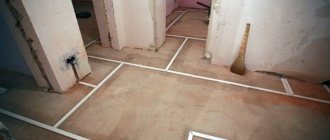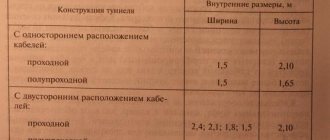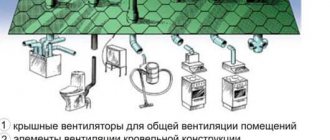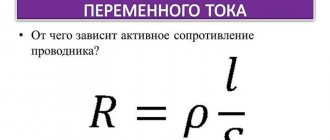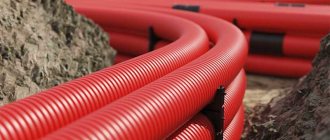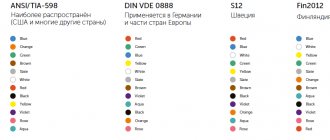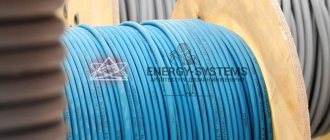Technical Circular 16/2007 On laying mutually redundant cables in trenches
3. TECHNICAL CIRCULAR No. 16/2007
“ABOUT LAYING MUTUALLY REDUNDATED CABLES IN TRENCHES”
Technical Circular No. 16/2007 was approved on September 14, 2007 by the Deputy Head of the Federal Service for Environmental, Technological and Nuclear Supervision K.L. Chaika. and approved by the President of the Association "Roselektromontazh" Khomitsky E.F.
Entered into force on September 14, 2007.
ASSOCIATION "ROSELEKTROMONTAZH"
TECHNICAL CIRCULAR
№ 16/2007
About laying mutually redundant cables in trenches
The issue of laying mutually redundant cable lines in the ground is not reflected in the existing PUE.
At one time, the conditions for laying mutually redundant cable lines in the ground were regulated by the “Instructions for the design of power supply for industrial enterprises” SN 174-75, according to which mutually redundant cables supplying category I consumers must be laid in different trenches with a distance between trenches of at least 1 m.
In the technological design standards NTP EPP-94, which were issued by VNIPI Tyazhpromelektroproekt to replace SN 174-75 and in the draft Chapter 2.3 of the seventh edition of the PUE, requirements for laying mutually redundant cables in trenches are not included.
Thus, in the current regulatory documents there are practically no instructions on the rules for designing mutually redundant cable lines.
The absence of these standards leads to difficulties in design and does not allow, in some cases, to make technically sound decisions.
The purpose of this circular is to eliminate gaps in current regulatory documents and issue specific recommendations for the design of mutually redundant cable lines.
When designing mutually redundant cable lines, you must be guided by the following:
1. It is recommended to lay mutually redundant cables along different routes, i.e. in different trenches with a distance between trenches of at least 1 m or lay cables in one trench with a distance between groups of cables of at least 1 m.
2. The distance between the trenches increases to 3 m for cables from the third source to power receivers of a special group of category I.
3. In cramped conditions, for example for urban infrastructure facilities, it is allowed to lay mutually redundant cable lines in one trench with a reduction in the distances between them, with the exception of the third line for powering power receivers of the first category of a special group.
Joint installation with a reduced distance is carried out in accordance with the requirements of clause 2.3.86 of the PUE, sixth edition, provided that the cables are protected from damage that may occur during a short circuit in one of the cables.
4. If necessary, protection of cables must be ensured from damage during excavation work, for example, installation in pipes.
files.stroyinf.ru
How to insert a wire into a hose
Correct connection of the string with the wire installed in the corrugation.
It is recommended that two people perform the work. This is due to the algorithm of actions.
- Remove the end of the wire (a kind of cable or string) from the hose and connect it to the cable being installed. A hole is made in the wire winding, a thin wire is pushed through it and securely fixed by twisting.
- The hose is leveled along its entire length, only after this can you begin to wind the cable into the corrugation.
- One worker firmly holds the end of the pipe from which the cable is wound, and the second pulls the wire from the other side. This approach allows the wire to be pushed through efficiently.
- The fully extended wire must be wound to the pipe to prevent the structures from moving relative to each other.
There are common cases when the wire gets stuck inside the corrugation. This is due to the weakening of its tension or the formation of bends. Until the end of the pulling process, it is important to monitor the condition of the hose.
Rostechnadzor explains: Joint laying of cables, connection of different sections
05/17/2015 edition dated 04/10/2018
Question from 01/19/2018:
How is it necessary to practically connect electrical wires up to 1000 V of various cross-sections (1.5 - 10mm2)?
Answer: The Department considered the appeal dated January 12, 2018 No. 25/3-og and explained that the connection of electrical wires should be carried out in accordance with GOST 10434-82 “Contact electrical connections.” Decisions on connection methods (options) for electrical wires and cables can be reflected in the design documentation.
Question:
Rostechnadzor received a request to provide information on regulatory documents regulating the joint laying of cables.
Answer: Specialists from the Department of State Construction Supervision of Rostechnadzor answered this question.
Information on joint cabling is given, in particular, in the documents listed below.
In accordance with clause 2.1.15 of the Rules for the Construction of Electrical Installations (hereinafter - PUE) (sixth edition), joint laying of wires and cables (with the exception of mutually redundant ones) is allowed in steel and other mechanical strong pipes, hoses, boxes, trays and closed channels of building structures. :
- All circuits of one unit.
- Power and control circuits of several machines, panels, panels, consoles, etc., connected by a technological process.
- Circuits powering a complex lamp.
- Circuits of several groups of one type of lighting (working or emergency) with a total number of wires in the pipe no more than eight.
- Lighting circuits up to 42 V with circuits above 42 V, provided that the wires of circuits up to 42 V are enclosed in a separate insulating pipe.
According to clause 2.1.16 of the PUE, in one pipe, sleeve, box, bundle, closed channel of a building structure or on one tray, the joint installation of mutually redundant circuits, circuits of working and emergency evacuation lighting, as well as circuits up to 42 V with circuits above 42 V is prohibited ( for an exception, see 2.1.15, clause 5 and 6.1.16, clause 1 of the PUE). The laying of these chains is allowed only in different compartments of boxes and trays that have solid longitudinal partitions with a fire resistance limit of at least 0.25 hours made of fireproof material.
It is allowed to lay emergency (evacuation) and working lighting circuits on different outer sides of the profile (channel, angle, etc.).
The Technical Circular of the Association “Roselectromontazh” dated September 13, 2007 No. 16/2007 “On laying mutually redundant cables in trenches” states that when designing mutually redundant cable lines, one must be guided by the following:
- It is recommended to lay mutually redundant cables along different routes, i.e. in different trenches with a distance between trenches of at least 1 m, or to lay cables in the same trench with a distance between groups of cables of at least 1 m.
- The distance between the trenches increases to 3 m for cables from the third source to power receivers of a special group of category I.
- In cramped conditions, for example, for urban infrastructure facilities, it is allowed to lay mutually redundant cable lines in one trench with a reduction in the distances between them, with the exception of the third line for powering power receivers of category I of a special group.
Joint installation with a reduced distance is carried out in accordance with the requirements of clause 2.3.86 of the PUE, sixth edition, provided that the cables are protected from damage that may occur during a short circuit in one of the cables.
Also, the requirements for the proximity of electrical wiring with other utility networks are established in clause 528 of the National Standard of the Russian Federation “Low-voltage electrical installations. Part 5-52. Selection and installation of electrical equipment. Electrical wiring" GOST R 50571.5.52-2011/IEC 60364-5-52:2009, approved and put into effect by order of the Federal Agency for Technical Regulation and Metrology dated December 13, 2011 No. 925-st.
tk-servis.ru
What is corrugation
Installation of cables in corrugated cables
Corrugated cables, despite their simple design, are considered one of the most useful and sought-after inventions of mankind. Visually, it is a pipe with a ribbed surface, which simultaneously gives it rigidity and flexibility. Corrugated pipes are made from various materials, the most popular being metal, aluminum, and plastic pipes.
Corrugation comes in different diameters, the indicators range from 10 mm to 2 m. This product has a wide range of applications.
Technical Circular 16/2007. About laying mutually redundant cables in trenches
3. TECHNICAL CIRCULAR No. 16/2007
“ABOUT LAYING MUTUALLY REDUNDATED CABLES IN TRENCHES”
Technical Circular No. 16/2007 was approved on September 14, 2007 by the Deputy Head of the Federal Service for Environmental, Technological and Nuclear Supervision K.L. Chaika. and approved by the President of the Association "Roselektromontazh" Khomitsky E.F.
Entered into force on September 14, 2007.
ASSOCIATION "ROSELEKTROMONTAZH"
TECHNICAL CIRCULAR
№ 16/2007
About laying mutually redundant cables in trenches
The issue of laying mutually redundant cable lines in the ground is not reflected in the existing PUE.
At one time, the conditions for laying mutually redundant cable lines in the ground were regulated by the “Instructions for the design of power supply for industrial enterprises” SN 174-75, according to which mutually redundant cables supplying category I consumers must be laid in different trenches with a distance between trenches of at least 1 m.
In the technological design standards NTP EPP-94, which were issued by VNIPI Tyazhpromelektroproekt to replace SN 174-75 and in the draft Chapter 2.3 of the seventh edition of the PUE, requirements for laying mutually redundant cables in trenches are not included.
Thus, in the current regulatory documents there are practically no instructions on the rules for designing mutually redundant cable lines.
The absence of these standards leads to difficulties in design and does not allow, in some cases, to make technically sound decisions.
The purpose of this circular is to eliminate gaps in current regulatory documents and issue specific recommendations for the design of mutually redundant cable lines.
When designing mutually redundant cable lines, you must be guided by the following:
1. It is recommended to lay mutually redundant cables along different routes, i.e. in different trenches with a distance between trenches of at least 1 m or lay cables in one trench with a distance between groups of cables of at least 1 m.
2. The distance between the trenches increases to 3 m for cables from the third source to power receivers of a special group of category I.
3. In cramped conditions, for example for urban infrastructure facilities, it is allowed to lay mutually redundant cable lines in one trench with a reduction in the distances between them, with the exception of the third line for powering power receivers of the first category of a special group.
Joint installation with a reduced distance is carried out in accordance with the requirements of clause 2.3.86 of the PUE, sixth edition, provided that the cables are protected from damage that may occur during a short circuit in one of the cables.
4. If necessary, protection of cables must be ensured from damage during excavation work, for example, installation in pipes.
snipov.net
Scope of application of corrugated pipes
Corrugated pipes provide the opportunity to lay air ducts of any complexity and length with the least number of turns and connecting nodes.
Corrugated pipes are widely used in various fields of industry, as well as for domestic purposes. In demand when performing the following installation work:
- installation of exhaust duct and ventilation system;
- for drainage of condensate they are equipped with air conditioners and split systems;
- used for connections in plumbing, for example, to connect a drain siphon to a sewer system;
- in the automotive industry to drain condensate and protect wires from thermal and chemical influences;
- for connecting boilers, ovens and stoves;
- for connecting heating systems.
For electrical cables, special electrical corrugations made of polyvinyl chloride are most often used.
